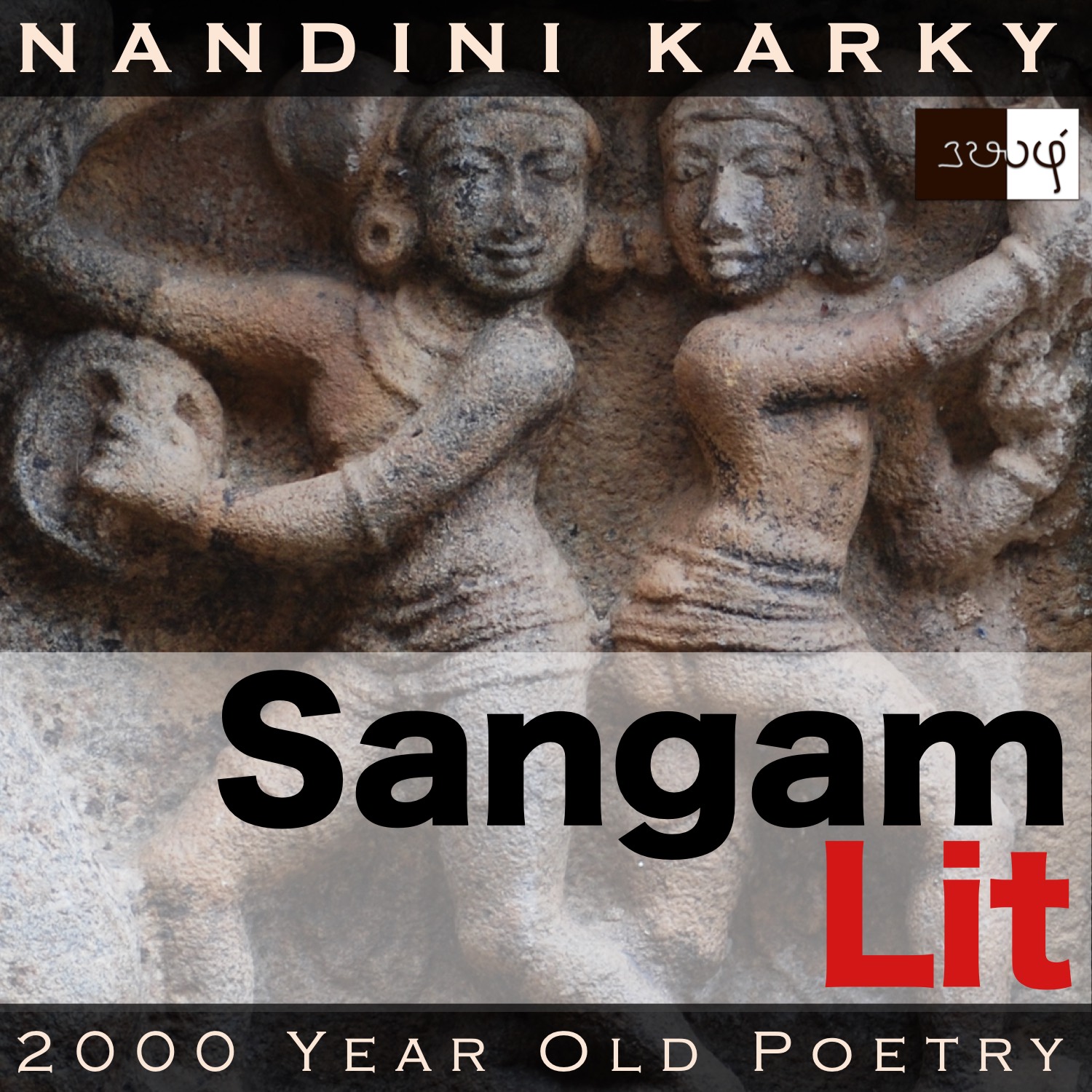Podcast: Play in new window | Download
Subscribe: Apple Podcasts | Spotify | Amazon Music | Android | iHeartRadio | Email | TuneIn | RSS | More

In this episode, we relish the emotions and imagery depicted in Sangam literary work, Natrinai 39, written by Maruthan Ilanaakanaar, set in the lush ‘Kurinji’ landscape or the mountainous regions. The words are said by the man to the lady, expressing those fervent feelings on beholding his love.
சொல்லின் சொல் எதிர்கொள்ளாய், யாழ நின்
திருமுகம் இறைஞ்சி நாணுதி கதுமென;
காமம் கைம்மிகின் தாங்குதல் எளிதோ?
கொடுங் கேழ் இரும் புறம் நடுங்கக் குத்திப்
புலி விளையாடிய புலவு நாறு வேழத்தின்
தலை மருப்பு ஏய்ப்ப, கடை மணி சிவந்த நின்
கண்ணே கதவ? அல்ல; நண்ணார்
அரண் தலை மதிலராகவும், முரசு கொண்டு,
ஓம்பு அரண் கடந்த அடு போர்ச் செழியன்
பெரும் பெயர்க் கூடல் அன்ன நின்
கரும்புடைத் தோளும் உடையவால் அணங்கே.
This poem was love at first sight for me, and that too, first sight of the first line. Indeed the phrase ’சொல்லின் சொல்’ had me at hello! To put it in simple words, it means ‘a word for my word’ or even simpler, ‘a reply’. What a beautiful coinage for the business-like ‘respond’! When it comes to emotions, there was ‘நாணம்’ meaning ‘shyness’ and ‘காமம்’ meaning ‘desire’. While there was a strong sense of emotions associated with love, at the same time, there were images of war and attack as in ‘நடுங்கக் குத்தி’ meaning ‘attacking to make one shiver’ as well as ‘ஓம்பு அரண் கடந்த’ meaning ‘attacking and entering towering forts’! Love and war seem to riding with passion from opposite directions in this poem. Come, let’s find out how they meet.
The scene opens in a mountain country, filled with dense foliage. The background is that the man and the lady know each other and have been together. When the man chances upon the lady in the mountain forest alone one day, she bends her head upon seeing him. To the lady, the man says, “You say no word in reply to my word. Overcome with shyness, you lower your beautiful face and conceal it with your hands. Tell me, is it easy to bear if desire breaks free and flows out of one’s control? Arising out of the elephant’s attack, making the bright stripes on both sides of the tiger’s back shiver, with a smell of the raw flesh gored, glows the elephant’s red-tipped tusk. Like that tusk, I see your eyes are tinged in red with desire. Fearing that they may attack me, you hide the same with your hands. But is that the only thing devouring me? Even though enemies protected themselves with soaring forts, the great king Chezhiyan overcame them, proclaiming his victory over them with the resounding echoes of his drums. Like Chezhiyan’s beautiful capital city, the renowned Koodal, shines your shoulders painted with the shapes of sugarcane. Not just your fine face, those shoulders make me suffer too!” Saying this, perhaps the man entreats her to uncover her face and say a sweet word he wishes to hear.
Let’s follow the footprints of these words to reveal the fascinating facts in store. First little thing is the word ‘வேழம்’. I learnt that this word refers to ‘an elephant’. I already knew there were words like ‘களிறு’ and ‘வாரணம்’ for elephant and was excited to find one more word. Searching further, I found in Karefo’s Chol, there were more than forty Tamil words for ‘elephant’. Elephants must have meant much to the ancient Tamils to devote so much of their vocabulary to this gentle giant. In many Sangam poems, we see elephants coming in conflict with tigers and in many of those prior instances, it’s the tiger that inflicts suffering but here the gentler giant seems to have the winning hand. Pondering further, I see that it could be a hidden reference to the eyes of the gentle, shy lady attacking the heart of this man.
Moving on from that attack, we witness the attack of king Chezhiyan, who overcomes his enemies hiding in towering forts. Who is he? Chezhiyan is the name taken by early Pandya kings and this Chezhiyan found in Sangam poems is believed to be from the 2nd century BCE. This we know because it came to light in 2011 that a coin collector, Mr. Krishnamurthy, had a rare copper coin with the name ‘Chezhiyan’ in Tamil-Brahmi script. This coin also had carvings of a king sporting a long moustache and a sharp nose, wearing a head armour. On the other side, an elephant was inscribed along with the fish symbols of the Pandyas. A little thing like a coin sheds so much light on the past and lends a concrete value to these poetic references! With this famous Chezhiyan, let’s stride into his capital city, that well-known Koodal. Koodal is said to be another name for Madurai, the seat of Pandya kings, where Sangam poets were said to have assembled and created these works of art that we relish today. Once again, that lovely poetic tradition of using a city as a simile for a woman’s beauty can be seen in this poem. Those ancient cities must have been gorgeous indeed! Here, the shoulders of the woman is painted with the ‘Thoyyil’ art, wherein sandalwood is used to paint intricate lines and patterns. Specifically here, the painting of a sugarcane catches the eyes of this man and sends him to his sweet suffering.
Having savoured these images and similes, I can only bow to the penmanship of this ancient poet who brings before our eyes, the life and love that existed more than two thousand years ago. Here’s to writing that transcends the limits of space and time!




My word for your words,
this poem and your way of conveying the poetic images thorugh your ‘delicious’ voice is super brilliant 😍